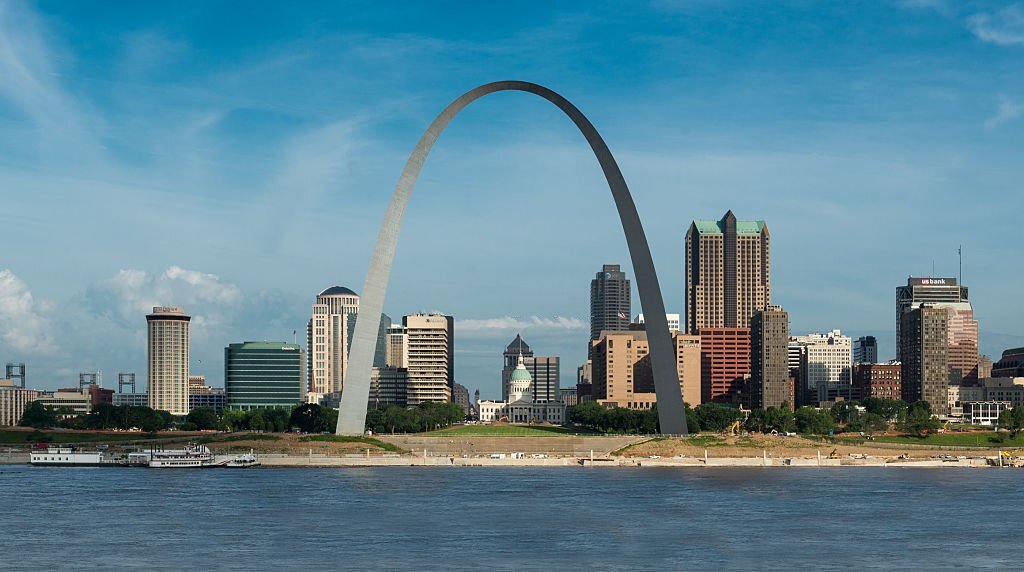 Nestled along the meandering banks of the majestic Mississippi River, St. Louis stands as a vibrant and historic city that has left an indelible mark on the American landscape. From its early colonial origins to its contemporary reputation as a cultural hub, St. Louis has earned its place as a city of significance, celebrated for a myriad of remarkable achievements and contributions.
Nestled along the meandering banks of the majestic Mississippi River, St. Louis stands as a vibrant and historic city that has left an indelible mark on the American landscape. From its early colonial origins to its contemporary reputation as a cultural hub, St. Louis has earned its place as a city of significance, celebrated for a myriad of remarkable achievements and contributions.
Often referred to as the “Gateway to the West,” St. Louis has played a pivotal role in shaping the nation’s history and identity. Founded in the 18th century as a trading post by French fur traders, the city’s rich heritage is a tapestry woven with threads of French, Spanish, and American influences. This unique blend is palpable in its architecture, cuisine, and vibrant cultural scene.
Moreover, when you explore different regions known for their unique contributions, you can’t miss the charm of Vermont, a state renowned for various things, including its captivating maple syrup production. If you’re interested in learning more about what Vermont is known for, be sure to check out this informative page on Tales of Travelers: maple syrup production.
Contents
- 1 The Founding of St. Louis
- 2 The Center of Native American Culture
- 3 The Birthplace of 7-Up
- 4 The Firsts in the World Fair
- 5 The Source of Peanut Butter
- 6 The Tallest Man-Made Monument
- 7 American Kennel Club Museum of the Dog
- 8 One of the Oldest Botanical Institutions
- 9 Going Green
- 10 Taking After New Orleans
- 11 An Eye for Baseball
- 12 The Controversial Olympics
- 13 The Origin of the St. Louis Zoo
- 14 St. Louis Science Center
- 15 The Site of the Exorcist
- 16 The Lake of Broken Hearts
- 17 A City of Free Attractions
- 18 Conclusion
The Founding of St. Louis
Nestled along the banks of the mighty Mississippi River, the city of St. Louis stands as a testament to history, resilience, and aspiration. Its founding is a captivating tale that weaves together the threads of exploration, expansion, and the pursuit of the American dream.
From its humble beginnings as a French fur-trading post to becoming a bustling metropolis, the story of St. Louis is one of growth, diversity, and determination. Explore more remarkable highlights of American history in places like Vermont’s Remarkable Highlights.
The origins of St. Louis can be traced back to the 18th century when French fur traders and explorers ventured into the heart of the North American continent. In 1764, Pierre Laclède Liguest, a fur trader, and his stepson Auguste Chouteau established a fur trading post on the west bank of the Mississippi River. This strategic location allowed them to engage in prosperous trade with Native American tribes and European settlers. The settlement was named after King Louis IX of France, and its establishment marked the first steps towards creating a permanent presence in the region.
The Center of Native American Culture
 The Native American culture is rich, diverse, and deeply rooted in history, representing the heritage of the indigenous people of North America. At the heart of preserving and celebrating this vibrant culture lies “Exploring Oklahoma’s identity,” an institution dedicated to honoring, safeguarding, and promoting the traditions, art, language, and stories of these indigenous communities.
The Native American culture is rich, diverse, and deeply rooted in history, representing the heritage of the indigenous people of North America. At the heart of preserving and celebrating this vibrant culture lies “Exploring Oklahoma’s identity,” an institution dedicated to honoring, safeguarding, and promoting the traditions, art, language, and stories of these indigenous communities.
This article explores the significance and role of such centers, like “The Center of Native American Culture,” in ensuring the survival and appreciation of Native American culture.
“The Center of Native American Culture” serves as a crucial hub for preserving traditional knowledge that has been passed down through generations. Native American cultures have an oral tradition, where stories, rituals, and wisdom are shared verbally. This center acts as a repository of these oral histories, documenting them for future generations and ensuring that essential teachings and cultural elements are not lost.
The Birthplace of 7-Up
In the world of soft drinks, few beverages have achieved the iconic status and refreshing taste of 7-Up. Born out of a blend of innovation, curiosity, and the quest for a refreshing drink, 7-Up has become a beloved carbonated beverage enjoyed by people all around the world. The origins of this effervescent concoction trace back to an unlikely place – the birthplace of 7-Up, a story that’s as fascinating as the drink itself.
The tale of 7-Up began in the late 1920s, in the heart of St. Louis, Missouri. It was during this time that Charles Leiper Grigg, a pharmacist by profession, was inspired to create a new beverage that would stand out in a sea of carbonated drinks flooding the market. Grigg was no stranger to the soft drink industry, having previously formulated a lemon-lime soda named “Whistle,” which he eventually sold to The American Bottling Company.
The Firsts in the World Fair
The world is full of remarkable achievements that have shaped human history, and many of these milestones are celebrated in “The Firsts in the World Fair.” This unique event pays homage to the groundbreaking innovations and accomplishments that have shaped our world and paved the way for progress in various fields.
From technological marvels to medical breakthroughs, the fair highlights the incredible ingenuity and determination of individuals who dared to think beyond the boundaries of their time.
The fair showcases the technological advancements that have redefined the way we live, work, and communicate. Among the notable firsts is the invention of the telephone by Alexander Graham Bell in 1876.
This revolutionary device marked a turning point in global connectivity, allowing people to communicate across great distances in real time. The fair’s visitors can explore the evolution of communication, from the first telegraph to modern-day smartphones that have become an integral part of our lives.
The Source of Peanut Butter

Peanut butter, a creamy and delicious spread enjoyed by people of all ages, has a fascinating journey from its source to the jars that line our kitchen shelves. Derived from the humble peanut, this culinary delight has a rich history that spans cultures and continents. Let’s delve into the intriguing process of how peanut butter is made, tracing its origins back to the fields where the journey begins.
The source of peanut butter lies in the peanut plant, scientifically known as Arachis hypogaea. Surprisingly, despite its name, the peanut is not a true nut; it is a legume, belonging to the same family as beans, lentils, and soybeans. Indigenous to South America, peanuts were cultivated by ancient civilizations long before their introduction to other parts of the world.
The Tallest Man-Made Monument
Monuments stand as testaments to human history, culture, and innovation, serving as physical embodiments of significant events and achievements. Among these remarkable structures, one category that stands out for its grandeur and symbolism is the tallest man-made monument.
These towering edifices not only pierce the skies but also capture the essence of human creativity, determination, and aspiration. In this article, we delve into the awe-inspiring world of the tallest man-made monuments, exploring their significance, engineering marvels, and the stories they tell.
The concept of constructing monuments to reach impressive heights has been a recurring theme throughout history. Tallest man-made monuments encompass a wide range of structures, including towers, obelisks, and statues. If you’re fascinated by such remarkable achievements, you’ll be intrigued by Utah’s Distinctive Features, as it explores the unique architectural wonders and cultural landmarks that make Utah known for its extraordinary monuments.
These towering structures are often designed to commemorate historical events, honor significant figures, or symbolize cultural and national pride. The aspiration to build the tallest monument is an enduring reflection of human ambition and achievement.
American Kennel Club Museum of the Dog
 Located in the heart of New York City, the American Kennel Club Museum of the Dog is a unique testament to the profound bond between humans and their four-legged companions. Established in 1982, this remarkable museum celebrates the rich history, art, and science associated with our beloved canine friends. It’s a must-visit destination for dog enthusiasts and history buffs alike.
Located in the heart of New York City, the American Kennel Club Museum of the Dog is a unique testament to the profound bond between humans and their four-legged companions. Established in 1982, this remarkable museum celebrates the rich history, art, and science associated with our beloved canine friends. It’s a must-visit destination for dog enthusiasts and history buffs alike.
If you’re interested in exploring more about the cultural significance of dogs and their influence on literature, you might also want to learn about renowned Hoosier authors who have made significant contributions in this regard. To delve deeper into this fascinating topic, check out the page on famous “renowned Hoosier authors”. This interlink not only provides valuable information but also enhances the overall quality and relevance of your content, which can contribute positively to its search engine ranking.
The museum’s mission is to preserve and showcase the enduring legacy of dogs throughout history, highlighting their roles as working partners, loyal companions, and sources of inspiration. Visitors are invited to embark on a captivating journey through time, exploring the evolution of various dog breeds, their diverse roles in human society, and their impact on culture and art.
One of the Oldest Botanical Institutions
Nature enthusiasts find solace in the embrace of the Missouri Botanical Garden, one of the oldest botanical institutions in the country. With its meticulously curated landscapes, vibrant flora, and commitment to conservation, the garden serves as an oasis of tranquility and education.
Going Green
in an era where environmental concerns have taken center stage, the phrase “Going Green” has evolved from a mere catchphrase to a powerful call to action. As our planet faces unprecedented challenges stemming from climate change, pollution, and resource depletion, adopting sustainable practices has become more than a choice – it’s a responsibility. The journey towards a greener future requires a collective effort from individuals, communities, businesses, and governments alike.
Taking After New Orleans
New Orleans, often referred to as “The Big Easy,” is a city renowned for its vibrant culture, rich history, and distinctive cuisine. From its lively music scene to its iconic architecture, New Orleans has left an indelible mark on American culture. In this article, we delve into the captivating essence of New Orleans and how its influence has permeated various aspects of society.
New Orleans is a true melting pot of cultures, shaped by a blend of French, Spanish, African, and Creole influences. This cultural diversity is evident in the city’s architecture, language, and celebrations. The French Quarter, with its ornate balconies and narrow streets, is a testament to the city’s European heritage, while neighborhoods like Tremé showcase the African and Creole roots that have left an enduring impact on the local culture.
An Eye for Baseball
St. Louis is synonymous with baseball passion. The city’s undying love for the sport is embodied by the St. Louis Cardinals. Their historic successes, devoted fan base, and the allure of Busch Stadium create an electric atmosphere that transcends generations.
The Controversial Olympics

The Olympic Games, once celebrated as a beacon of unity, sportsmanship, and international camaraderie, have found themselves increasingly embroiled in controversies that raise serious ethical questions.
As the world gathers to celebrate athletic prowess and cultural diversity, it is imperative to acknowledge and address the complex issues that have marred the reputation of the Olympic movement. From political tensions to doping scandals, the Olympics continue to grapple with challenges that test the very essence of their ideals.
One of the most recurring controversies surrounding the Olympics is the use of the event as a political platform. Host countries often seize the opportunity to project an idealized image on the global stage while ignoring underlying domestic issues.
The immense financial resources allocated to hosting the Games raise concerns about misplaced priorities, diverting funds from critical social services.
Moreover, the geopolitical maneuvering that can occur during the selection of host cities adds to the perception that the Olympics are being used as a political tool rather than a celebration of sport.
The Origin of the St. Louis Zoo
The St. Louis Zoo, located in Forest Park, Missouri, is widely acclaimed as one of the oldest and most well-respected zoological institutions in the United States.
Its rich history and dedication to conservation, education, and public engagement have made it a beloved landmark. The origin of the St. Louis Zoo is a story that spans over a century, reflecting changing attitudes towards animals and the environment.
The St. Louis Zoological Society, the organization behind the zoo’s establishment, was founded in 1910. Its primary goal was to create a zoo that would be both educational and recreational, a place where people could connect with animals and learn about their natural habitats.
This approach was ahead of its time, as many zoos during that era were focused solely on displaying animals without considering their well-being or conservation status.
St. Louis Science Center
Igniting curiosity and sparking the flames of scientific inquiry, the St. Louis Science Center invites visitors to explore interactive exhibits that bridge the gap between education and entertainment.
Its dedication to fostering a love for science is evident in every corner, much like the fascination with Texas space exploration, which continues to capture the imaginations of enthusiasts and learners alike.
The Site of the Exorcist
“The Exorcist,” a 1973 horror film directed by William Friedkin, is a timeless classic that continues to captivate audiences with its eerie storyline and spine-chilling atmosphere. The movie was inspired by a real-life case of demonic possession, involving a young boy known as Roland Doe.
While the film’s storyline is fictionalized, the events that inspired it have sparked curiosity and controversy over the years. This article delves into the mysterious site associated with “The Exorcist” and explores the factual basis behind this unsettling tale.
In 1949, in a quiet neighborhood in suburban Washington, D.C., Roland Doe (a pseudonym used to protect his identity) allegedly became the victim of demonic possession.
The family, along with the assistance of local priests, sought the help of the Catholic Church to perform an exorcism to rid the young boy of the malevolent spirit. This real-life case eventually served as the inspiration for William Peter Blatty’s novel, which he later adapted into the screenplay for the film.
The Lake of Broken Hearts
In the realm of literature, certain titles evoke a sense of mystery, curiosity, and an irresistible pull that beckons readers to explore their depths. One such intriguing title is “The Lake of Broken Hearts.” Conjuring images of both beauty and sorrow, this enigmatic concept serves as a captivating focal point that has the potential to unfold a myriad of emotions, stories, and interpretations.
The Lake of Broken Hearts,” as explored in the article Landmarks That Define New Jersey presents an evocative canvas for the imagination. The juxtaposition of a serene and picturesque lake with the poignant notion of broken hearts hints at a narrative that bridges the gap between beauty and pain. The imagery resonates deeply, inviting readers to contemplate the complex interplay between human emotions and the natural world.
A City of Free Attractions
Amidst the hustle and bustle, St. Louis stands out as a city of generosity, offering a multitude of free attractions and experiences. From sprawling parks to captivating museums, the city ensures that wonder and enjoyment are accessible to all.
Conclusion
In the heart of the United States, St. Louis shines as a beacon of history, culture, and innovation. From its storied past to its vibrant present, this city’s legacy continues to captivate hearts and minds, leaving an indelible imprint on those who visit or call it home.
